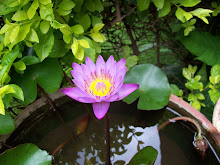 In India, Vinca is known as Sadabahar, which means always cheerful. Ihe plant has flowers throughout the year. It does not need any special care . It thrives in poor soils also.
In India, Vinca is known as Sadabahar, which means always cheerful. Ihe plant has flowers throughout the year. It does not need any special care . It thrives in poor soils also.The flowers are many colours , the most common being the white and the pink . Vinca which is a tropical and subtropical plant has been used in Indian and Chinese traditional medicine since centuries. In India, it is used to treat diabetes and malaria and for insect bites. It is also used to treat certain cancers. The substances, Vinblastine and Vincristine obtained from Vinca are used in the treatment of leukemia. The patenting of medicines from vinca has given rise to controversy as Vinca has been used for thousands of years in India and China for its medicinal properties.







